

Crinums are tough, long-lived perennial bulbs with strappy leaves and fragrant, funnel-shaped flowers. In areas where the bulbs are hardy, (zones 5/6-10) these plants can reach as much as 4 feet across and bloom all summer. Crinums can live for 200-300 years in the South often found growing in cemeteries and abandoned home sites with little or no attention. The plants are native to southeast Asia often in areas with a summer monsoon and dry winter. They can also be grown as flowering summer patio plants. If growing as a potted plant and trying to overwinter, allowing the foliage to frost is ok, it will not kill the root system. However, do not allow the pot with rootball to freeze solid or go below 20 degrees for more than a few hours; move into a cold garage or basement over the winter with no watering. Cut back and allow to go dormant and place entire pot back out in April or May with a time-release fertilizer. During the growing season, fertilize, water regularly, and place in full sun. You may also plant these in the ground for an enormous tropical effect! It is easy to overwinter these in the ground in Kansas with mulch or no mulch! The trick is to plant them deep: an extra 4-6" deeper than grade or with neck of bulb completely buried. Crinums are extremely adaptable thriving in either in dry or in boggy soils. Crinums are tough, low maintenance bulbs which make them perfect for rain gardens, and although drought-tolerant, crinums bloom more if well-watered. This plant can also grow in standing water or as a potted plant in water gardens. Unlike southern climates, crinums in Kansas need full sun to grow and flower in our shorter growing season. Crinum are more cold hardy than most authorities publish; easily pushing into zone 5 for some varieties. In our trial gardens in Lawrence, KS (zone 6a), the following varieties survived after being mulched 6-12" with leaf mulch to -17 degrees F. (Crinum 'Infusion', Crinum tweedianum, Crinum 'Super Ellen', Crinum x powellii, Crinum 'White Prince') During the arctic blast of February, 2021, lows down to -17 degrees F on Feb 16th, 2021 were recorded. The longevity of this cold blast was also impressive: 10 days on a row with highs of 10-15 degrees F or lower, 8 nights of lows in the single digits and negatives, and 36 straight hours of 0 degrees F and mostly lower. No crinums were lost or harmed during this event! Crinum 'Infusion' is a large crinum up to 48" tall with magenta flowers. Offsets heavily. Hardy to Zone 5b.
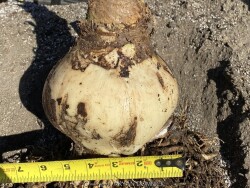

Crinums are tough, long-lived perennial bulbs with strappy leaves and fragrant, funnel-shaped flowers. In areas where the bulbs are hardy, (zones 5/6-10) these plants can reach as much as 4 feet across and bloom all summer. Crinums can live for 200-300 years in the South often found growing in cemeteries and abandoned home sites with little or no attention. The plants are native to southeast Asia often in areas with a summer monsoon and dry winter. They can also be grown as flowering summer patio plants. If growing as a potted plant and trying to overwinter, allowing the foliage to frost is ok, it will not kill the root system. However, do not allow the pot with rootball to freeze solid or go below 20 degrees for more than a few hours; move into a cold garage or basement over the winter with no watering. Cut back and allow to go dormant and place entire pot back out in April or May with a time-release fertilizer. During the growing season, fertilize, water regularly, and place in full sun. You may also plant these in the ground for an enormous tropical effect! It is easy to overwinter these in the ground in Kansas with mulch or no mulch! The trick is to plant them deep: an extra 4-6" deeper than grade or with neck of bulb completely buried. Crinums are extremely adaptable thriving in either in dry or in boggy soils. Crinums are tough, low maintenance bulbs which make them perfect for rain gardens, and although drought-tolerant, crinums bloom more if well-watered. This plant can also grow in standing water or as a potted plant in water gardens. Unlike southern climates, crinums in Kansas need full sun to grow and flower in our shorter growing season. Crinum are more cold hardy than most authorities publish; easily pushing into zone 5 for some varieties. In our trial gardens in Lawrence, KS (zone 6a), the following varieties survived after being mulched 6-12" with leaf mulch to -17 degrees F. (Crinum 'Infusion', Crinum tweedianum, Crinum 'Super Ellen', Crinum x powellii, Crinum 'White Prince') During the arctic blast of February, 2021, lows down to -17 degrees F on Feb 16th, 2021 were recorded. The longevity of this cold blast was also impressive: 10 days on a row with highs of 10-15 degrees F or lower, 8 nights of lows in the single digits and negatives, and 36 straight hours of 0 degrees F and mostly lower. No crinums were lost or harmed during this event! Crinum 'Infusion' is a large crinum up to 48" tall with magenta flowers. Offsets heavily. Hardy to Zone 5b.
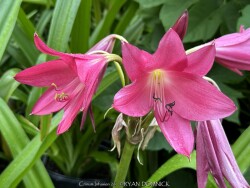

Crinums are tough, long-lived perennial bulbs with strappy leaves and fragrant, funnel-shaped flowers. In areas where the bulbs are hardy, (zones 5/6-10) these plants can reach as much as 4 feet across and bloom all summer. Crinums can live for 200-300 years in the South often found growing in cemeteries and abandoned home sites with little or no attention. The plants are native to southeast Asia often in areas with a summer monsoon and dry winter. They can also be grown as flowering summer patio plants. If growing as a potted plant and trying to overwinter, allowing the foliage to frost is ok, it will not kill the root system. However, do not allow the pot with rootball to freeze solid or go below 20 degrees for more than a few hours; move into a cold garage or basement over the winter with no watering. Cut back and allow to go dormant and place entire pot back out in April or May with a time-release fertilizer. During the growing season, fertilize, water regularly, and place in full sun. You may also plant these in the ground for an enormous tropical effect! It is easy to overwinter these in the ground in Kansas with mulch or no mulch! The trick is to plant them deep: an extra 4-6" deeper than grade or with neck of bulb completely buried. Crinums are extremely adaptable thriving in either in dry or in boggy soils. Crinums are tough, low maintenance bulbs which make them perfect for rain gardens, and although drought-tolerant, crinums bloom more if well-watered. This plant can also grow in standing water or as a potted plant in water gardens. Unlike southern climates, crinums in Kansas need full sun to grow and flower in our shorter growing season. Crinum are more cold hardy than most authorities publish; easily pushing into zone 5 for some varieties. In our trial gardens in Lawrence, KS (zone 6a), the following varieties survived after being mulched 6-12" with leaf mulch to -17 degrees F. (Crinum 'Infusion', Crinum tweedianum, Crinum 'Super Ellen', Crinum x powellii, Crinum 'White Prince') During the arctic blast of February, 2021, lows down to -17 degrees F on Feb 16th, 2021 were recorded. The longevity of this cold blast was also impressive: 10 days on a row with highs of 10-15 degrees F or lower, 8 nights of lows in the single digits and negatives, and 36 straight hours of 0 degrees F and mostly lower. No crinums were lost or harmed during this event! Crinum 'Infusion' is a large crinum up to 48" tall with magenta flowers. Offsets heavily. Hardy to Zone 5b.
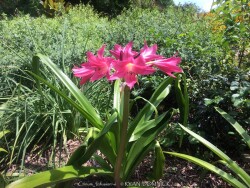

Crinums are tough, long-lived perennial bulbs with strappy leaves and fragrant, funnel-shaped flowers. In areas where the bulbs are hardy, (zones 5/6-10) these plants can reach as much as 4 feet across and bloom all summer. Crinums can live for 200-300 years in the South often found growing in cemeteries and abandoned home sites with little or no attention. The plants are native to southeast Asia often in areas with a summer monsoon and dry winter. They can also be grown as flowering summer patio plants. If growing as a potted plant and trying to overwinter, allowing the foliage to frost is ok, it will not kill the root system. However, do not allow the pot with rootball to freeze solid or go below 20 degrees for more than a few hours; move into a cold garage or basement over the winter with no watering. Cut back and allow to go dormant and place entire pot back out in April or May with a time-release fertilizer. During the growing season, fertilize, water regularly, and place in full sun. You may also plant these in the ground for an enormous tropical effect! It is easy to overwinter these in the ground in Kansas with mulch or no mulch! The trick is to plant them deep: an extra 4-6" deeper than grade or with neck of bulb completely buried. Crinums are extremely adaptable thriving in either in dry or in boggy soils. Crinums are tough, low maintenance bulbs which make them perfect for rain gardens, and although drought-tolerant, crinums bloom more if well-watered. This plant can also grow in standing water or as a potted plant in water gardens. Unlike southern climates, crinums in Kansas need full sun to grow and flower in our shorter growing season. Crinum are more cold hardy than most authorities publish; easily pushing into zone 5 for some varieties. In our trial gardens in Lawrence, KS (zone 6a), the following varieties survived after being mulched 6-12" with leaf mulch to -17 degrees F. (Crinum 'Infusion', Crinum tweedianum, Crinum 'Super Ellen', Crinum x powellii, Crinum 'White Prince') During the arctic blast of February, 2021, lows down to -17 degrees F on Feb 16th, 2021 were recorded. The longevity of this cold blast was also impressive: 10 days on a row with highs of 10-15 degrees F or lower, 8 nights of lows in the single digits and negatives, and 36 straight hours of 0 degrees F and mostly lower. No crinums were lost or harmed during this event! Crinum 'Infusion' is a large crinum up to 48" tall with magenta flowers. Offsets heavily. Hardy to Zone 5b.
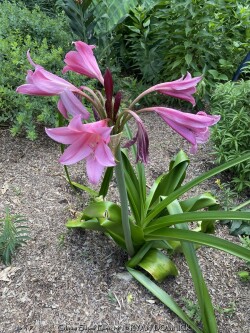

Crinums are tough, long-lived perennial bulbs with strappy leaves and fragrant, funnel-shaped flowers. In areas where the bulbs are hardy, (zones 5/6-10) these plants can reach as much as 4 feet across and bloom all summer. Crinums can live for 200-300 years in the South often found growing in cemeteries and abandoned home sites with little or no attention. The plants are native to southeast Asia often in areas with a summer monsoon and dry winter. They can also be grown as flowering summer patio plants. If growing as a potted plant and trying to overwinter, allowing the foliage to frost is ok, it will not kill the root system. However, do not allow the pot with rootball to freeze solid or go below 20 degrees for more than a few hours; move into a cold garage or basement over the winter with no watering. Cut back and allow to go dormant and place entire pot back out in April or May with a time-release fertilizer. During the growing season, fertilize, water regularly, and place in full sun. You may also plant these in the ground for an enormous tropical effect! It is easy to overwinter these in the ground in Kansas with mulch or no mulch! The trick is to plant them deep: an extra 4-6" deeper than grade or with neck of bulb completely buried. Crinums are extremely adaptable thriving in either in dry or in boggy soils. Crinums are tough, low maintenance bulbs which make them perfect for rain gardens, and although drought-tolerant, crinums bloom more if well-watered. This plant can also grow in standing water or as a potted plant in water gardens. Unlike southern climates, crinums in Kansas need full sun to grow and flower in our shorter growing season. Crinum are more cold hardy than most authorities publish; easily pushing into zone 5 for some varieties. In our trial gardens in Lawrence, KS (zone 6a), the following varieties survived after being mulched 6-12" with leaf mulch to -17 degrees F. (Crinum 'Infusion', Crinum tweeedianum, Crinum 'Super Ellen', Crinum x powellii, Crinum 'White Prince') During the arctic blast of February, 2021, lows down to -17 degrees F on Feb 16th, 2021 were recorded. The longevity of this cold blast was also impressive: 10 days on a row with highs of 10-15 degrees F or lower, 8 nights of lows in the single digits and negatives, and 36 straight hours of 0 degrees F and mostly lower. No crinums were lost or harmed during this event! Crinum 'Super Ellen' is a massive crinum (cross of Crinum 'Ellen Bosanquet' x Crinum bulbispermum) up to 60" tall with magenta flowers. Offsets heavily.
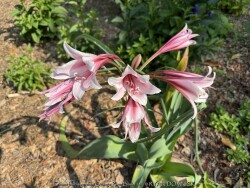

Crinums are tough, long-lived perennial bulbs with strappy leaves and fragrant, funnel-shaped flowers. In areas where the bulbs are hardy, (zones 5/6-10) these plants can reach as much as 4 feet across and bloom all summer. Crinums can live for 200-300 years in the South often found growing in cemeteries and abandoned home sites with little or no attention. The plants are native to southeast Asia often in areas with a summer monsoon and dry winter. They can also be grown as flowering summer patio plants. If growing as a potted plant and trying to overwinter, allowing the foliage to frost is ok, it will not kill the root system. However, do not allow the pot with rootball to freeze solid or go below 20 degrees for more than a few hours; move into a cold garage or basement over the winter with no watering. Cut back and allow to go dormant and place entire pot back out in April or May with a time-release fertilizer. During the growing season, fertilize, water regularly, and place in full sun. You may also plant these in the ground for an enormous tropical effect! It is easy to overwinter these in the ground in Kansas with mulch or no mulch! The trick is to plant them deep: an extra 4-6" deeper than grade or with neck of bulb completely buried. Crinums are extremely adaptable thriving in either in dry or in boggy soils. Crinums are tough, low maintenance bulbs which make them perfect for rain gardens, and although drought-tolerant, crinums bloom more if well-watered. Unlike southern climates, crinums in Kansas need full sun to grow and flower in our shorter growing season. Crinum are more cold hardy than most authorities publish; easily pushing into zone 5 for some varieties. In our trial gardens in Lawrence, KS (zone 6a), the following varieties survived after being mulched 6-12" with leaf mulch to -17 degrees F. (Crinum 'Infusion', Crinum tweedianum, Crinum 'Super Ellen', Crinum x powellii, Crinum 'White Prince') During the arctic blast of February, 2021, lows down to -17 degrees F on Feb 16th, 2021 were recorded. The longevity of this cold blast was also impressive: 10 days on a row with highs of 10-15 degrees F or lower, 8 nights of lows in the single digits and negatives, and 36 straight hours of 0 degrees F and mostly lower. No crinums were lost or harmed during this event! Crinum bulbispermum 'Orange River Basin' is a form of the extremely winter hardy (zone 5) Crinum bulbispermum from South Africa's Orange River area at around 9,000' elevation 'Orange River Basin' forms a lovely non-offsetting clump of glaucous blue foliage and white flowers with pink and magenta throat.
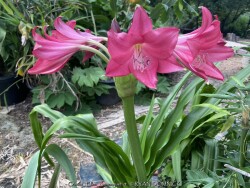

Crinums are tough, long-lived perennial bulbs with strappy leaves and fragrant, funnel-shaped flowers. In areas where the bulbs are hardy, (zones 5/6-10) these plants can reach as much as 4 feet across and bloom all summer. Crinums can live for 200-300 years in the South often found growing in cemeteries and abandoned home sites with little or no attention. The plants are native to southeast Asia often in areas with a summer monsoon and dry winter. They can also be grown as flowering summer patio plants. If growing as a potted plant and trying to overwinter, allowing the foliage to frost is ok, it will not kill the root system. However, do not allow the pot with rootball to freeze solid or go below 20 degrees for more than a few hours; move into a cold garage or basement over the winter with no watering. Cut back and allow to go dormant and place entire pot back out in April or May with a time-release fertilizer. During the growing season, fertilize, water regularly, and place in full sun. You may also plant these in the ground for an enormous tropical effect! It is easy to overwinter these in the ground in Kansas with mulch or no mulch! The trick is to plant them deep: an extra 4-6" deeper than grade or with neck of bulb completely buried. Crinums are extremely adaptable thriving in either in dry or in boggy soils. Crinums are tough, low maintenance bulbs which make them perfect for rain gardens, and although drought-tolerant, crinums bloom more if well-watered. This plant can also grow in standing water or as a potted plant in water gardens. Unlike southern climates, crinums in Kansas need full sun to grow and flower in our shorter growing season. Crinum are more cold hardy than most authorities publish; easily pushing into zone 5 for some varieties. In our trial gardens in Lawrence, KS (zone 6a), the following varieties survived after being mulched 6-12" with leaf mulch to -17 degrees F. (Crinum 'Infusion', Crinum tweedianum, Crinum 'Super Ellen', Crinum x powellii, Crinum 'White Prince') During the arctic blast of February, 2021, lows down to -17 degrees F on Feb 16th, 2021 were recorded. The longevity of this cold blast was also impressive: 10 days on a row with highs of 10-15 degrees F or lower, 8 nights of lows in the single digits and negatives, and 36 straight hours of 0 degrees F and mostly lower. No crinums were lost or harmed during this event!
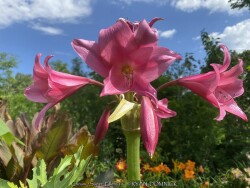

Crinums are tough, long-lived perennial bulbs with strappy leaves and fragrant, funnel-shaped flowers. In areas where the bulbs are hardy, (zones 5/6-10) these plants can reach as much as 4 feet across and bloom all summer. Crinums can live for 200-300 years in the South often found growing in cemeteries and abandoned home sites with little or no attention. The plants are native to southeast Asia often in areas with a summer monsoon and dry winter. They can also be grown as flowering summer patio plants. If growing as a potted plant and trying to overwinter, allowing the foliage to frost is ok, it will not kill the root system. However, do not allow the pot with rootball to freeze solid or go below 20 degrees for more than a few hours; move into a cold garage or basement over the winter with no watering. Cut back and allow to go dormant and place entire pot back out in April or May with a time-release fertilizer. During the growing season, fertilize, water regularly, and place in full sun. You may also plant these in the ground for an enormous tropical effect! It is easy to overwinter these in the ground in Kansas with mulch or no mulch! The trick is to plant them deep: an extra 4-6" deeper than grade or with neck of bulb completely buried. Crinums are extremely adaptable thriving in either in dry or in boggy soils. Crinums are tough, low maintenance bulbs which make them perfect for rain gardens, and although drought-tolerant, crinums bloom more if well-watered. This plant can also grow in standing water or as a potted plant in water gardens. Unlike southern climates, crinums in Kansas need full sun to grow and flower in our shorter growing season. Crinum are more cold hardy than most authorities publish; easily pushing into zone 5 for some varieties. In our trial gardens in Lawrence, KS (zone 6a), the following varieties survived after being mulched 6-12" with leaf mulch to -17 degrees F. (Crinum 'Infusion', Crinum tweedianum, Crinum 'Super Ellen', Crinum x powellii, Crinum 'White Prince') During the arctic blast of February, 2021, lows down to -17 degrees F on Feb 16th, 2021 were recorded. The longevity of this cold blast was also impressive: 10 days on a row with highs of 10-15 degrees F or lower, 8 nights of lows in the single digits and negatives, and 36 straight hours of 0 degrees F and mostly lower. No crinums were lost or harmed during this event!
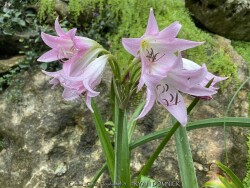

Crinums are tough, long-lived perennial bulbs with strappy leaves and fragrant, funnel-shaped flowers. In areas where the bulbs are hardy, (zones 5/6-10) these plants can reach as much as 4 feet across and bloom all summer. Crinums can live for 200-300 years in the South often found growing in cemeteries and abandoned home sites with little or no attention. The plants are native to southeast Asia often in areas with a summer monsoon and dry winter. They can also be grown as flowering summer patio plants. If growing as a potted plant and trying to overwinter, allowing the foliage to frost is ok, it will not kill the root system. However, do not allow the pot with rootball to freeze solid or go below 20 degrees for more than a few hours; move into a cold garage or basement over the winter with no watering. Cut back and allow to go dormant and place entire pot back out in April or May with a time-release fertilizer. During the growing season, fertilize, water regularly, and place in full sun. You may also plant these in the ground for an enormous tropical effect! It is easy to overwinter these in the ground in Kansas with mulch or no mulch! The trick is to plant them deep: an extra 4-6" deeper than grade or with neck of bulb completely buried. Crinums are extremely adaptable thriving in either in dry or in boggy soils. Crinums are tough, low maintenance bulbs which make them perfect for rain gardens, and although drought-tolerant, crinums bloom more if well-watered. This plant can also grow in standing water or as a potted plant in water gardens. Unlike southern climates, crinums in Kansas need full sun to grow and flower in our shorter growing season. Crinum are more cold hardy than most authorities publish; easily pushing into zone 5 for some varieties. In our trial gardens in Lawrence, KS (zone 6a), the following varieties survived after being mulched 6-12" with leaf mulch to -17 degrees F. (Crinum 'Infusion', Crinum tweedianum, Crinum 'Super Ellen', Crinum x powellii, Crinum 'White Prince') During the arctic blast of February, 2021, lows down to -17 degrees F on Feb 16th, 2021 were recorded. The longevity of this cold blast was also impressive: 10 days on a row with highs of 10-15 degrees F or lower, 8 nights of lows in the single digits and negatives, and 36 straight hours of 0 degrees F and mostly lower. No crinums were lost or harmed during this event! Crinum x powellii produces pink flowers. 48" tall
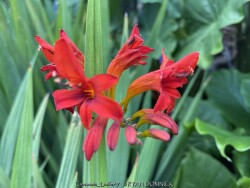

Lucifer Red Crocosmia (Crocosmia 'Lucifer') are typically grown for their bright red mid-summer flowers and vertical iris-leaf foliage. The plants are temperate and subtropical herbaceous perennial bulbs native to areas with a summer wet season and dry winter. Crocosmia are hardy outside as a perennial when established and with minimal effort at least up to zone 6a. During the growing season, fertilize, water regularly, and plant in full sun. Plant these bulbs in the ground at least 4-6" deep with 3-4" of mulch to enjoy a wonderful tropical flowering effect! Foliage may look bedwraggled by fall so it is ok to cut back foliage at that time. They can also be grown as a flowering summer patio plant. If growing as a potted plant and trying to overwinter, allowing the foliage to frost is ok, it will not kill the root system. However, do not allow the pot with rootball to freeze solid or go below 20 degrees for more than a few hours; move into a cold garage or basement over the winter with no watering. Cut back and allow to go dormant and place entire pot back out in April or May with a time-release fertilizer. Another more labor intensive way to overwinter crocosmia is to remove them from the dirt, dust with fungicide, place in box with sawdust, and keep in the refrigerator. We consider this method old-fashioned and too much work but ok if you only want to save a few bulbs. If digging from the ground in colder zones, just save a big chunk with the dirt intact and place into a large pot in the garage. In a customer's garden in Lawrence, KS (zone 6a), four established specimens planted over 4-6" deep and mulched 2-3" with wood mulch survived -17 degrees F. During the arctic blast of February, 2021, lows down to -17 degrees F on Feb 16th, 2021 were recorded. The longevity of this cold blast was also impressive: 10 days on a row with highs of 10-15 degrees F or lower, 8 nights of lows in the single digits and negatives, and 36 straight hours of 0 degrees F and mostly lower.
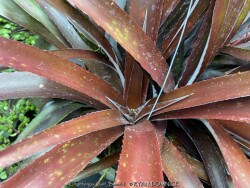

Red Burst Bromeliad (Cryptbergia 'Red Burst') is an intergeneric bromeliad hybrid that is a cross between Billbergia nutans x Cryptanthus bahianus. It forms rosettes of flattened 8-12" long pointed green/bronzy-red leaves. Color ranges from dark green in shade to more intense maroon in bright UV light. 'Red Burst' is usually grown as a patio or house plant in Kansas. Best grown in full to part sun with some extra watering including that which comes from rainfall. Repotting may or may not be needed depending on how large you want the plant to grow; plants can continue to grow thicker and tolerate extremely root-bound pots and bone dry soil. If repotting, make sure to use a cactus mix with some of sand and perlite. Although plants are hardy to 26-28 degrees F, potted plants are best moved in before night temperatures get below 35 degrees F. It is important to avoid the combination of wet and cold. Move to a bright interior window over the winter with no watering and keep above freezing. As a winter house plant, it will look presentable all winter long with just no waterings. As a permanent house plant, provide bright light and allow the soil to dry between waterings for many years of carefree enjoyment. Plants grown permanently indoors may begin to lose foliage color. It can be hard to reproduce the intense UV sunlight they need so moving outside for the summer is best. Generally if moving outside for the summer, allow 1-2 weeks of part shade or morning sun before placing in full sun. Plants with time to acclimate will thrive in full sun but be careful not to rush it or sunburning will occur. Potted plants are very low maintenance; no pests have ever been observed on this bullet-proof plant.
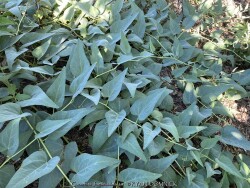

Buffalo Gourd (Cucurbita foetidissima) has large, gray-green, triangular leaves growing along long, prostrate stems. In the wild, the plants are often 20-30 feet across. Leaves are an attractive bluish green with a sandpapery texture. The large, bell-like flowers, 2-4 inches long, are yellow to orange, opening for only a day but blooming occurs over a month or so. The globular fruits, about 4 inches across, are green-striped when young, maturing to tennis-ball size and turning yellow. The plant supposedly gets the name "stink gourd" from its foul odor. Native to arid clay soils in Western Kansas, Colorado, the southwestern United States, and northern Mexico, the plant forms a fleshy tap root which is used to store water and nutrients. A large 10' wide specimen has flourished in our display garden in Lawrence, KS for over 10 years. It is planted in full sun in clay soil with no extra irrigation. It survived -16 degrees F and a week of single digit highs in February, 2021. It would be very useful as a vine-like perennial cascading over the top of a retaining wall! Amazing that a perennial native to areas receiving 5-10" of rain per year can grow in a climate receiving 5-10 times more rain!
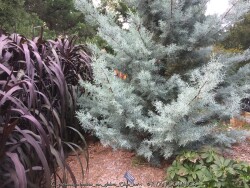

Blue Ice Arizona Cypress (Cupressus arizonica var. glabra 'Blue Ice') is a relatively new plant being used in Kansas zone 6. Originally native to desert areas of the Southwest and Mexico including dry mountain slopes, it seems pretty well adapted to our climate without many of the traditional pests that plague evergreens. Several 15-20 foot tall specimens can be observed in the Wichita botanical garden, Botanica. 'Blue Ice' Arizona Cypress is grown for its bluish nearly silver foliage, unique conical (pyramidal when young) growth form, and occasional silver fruit. Drainage definitely needs to be on the positive side but most soils seem okay. Planting on a South or West foundation is perfect. (or on a south facing berm) Extreme heat tolerance is not a problem opposed to cold-loving blue spruce. Growth is relatively fast at about 1 to 2 feet per year; also much faster than traditional blue spruce. Small established plants on a berm in Lawrence, Kansas handled the deep freeze of 2021 surviving -16 degrees F and a week of single digit highs with no damage. Definitely a plant for the future!
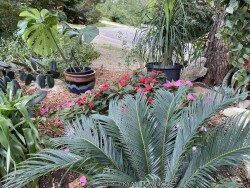

***Description for this plant available with future update!***Cycad / Sago Palm (Tropical), is also known as Cycas revoluta


This hardy Tree / Cane Cholla variety came to us from Yucca Pointe Nursery in Stillwater, OK where it grows outside in the owner Nathan Priest's display garden. This upright Cholla Cactus (Cylindropuntia imbricata) features magenta flowers and upright growth form are a unique addition to the garden. Native to arid clay soils in Western Kansas, Colorado, Oklahoma and parts of the southwestern United States and Mexico, the plant grows into a vicious unforgiving shrub if you get too close. From a distance however, this cactus has a place as one of the few upright cacti that can handle extreme cold. In fact, I have seen this species growing a few times in Lawrence, KS in desert gardens and even in full (dry) shade! Flowering in shade is doubtful though. With well drained soils and proper siting, this cactus can handle our excess rainfall in Eastern Kansas. We are testing this outside in our crevice garden among other hardy cacti and succulents! We will keep you posted. (2024)
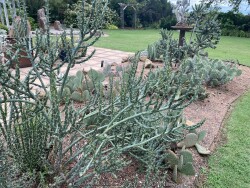

This hardy Klein's Cholla came to us from Oklahoma nursery near Tulsa. This upright Cholla Cactus Cylindropuntia kleiniae) features pink/magenta flowers and upright growth form are a unique addition to the garden. Native to arid clay soils in New Mexico and parts of the southwestern United States and Mexico (even possibly Oklahoma), the plant grows into a vicious unforgiving shrub if you get too close. From a distance however, this cactus has a place as one of the few upright cacti that can handle extreme cold when kept dry. With very well drained soils and proper siting, this cactus seems to take our excess rainfall in Eastern Kansas. We are testing this outside in our crevice garden among other hardy cacti and succulents! We will keep you posted. (2024)
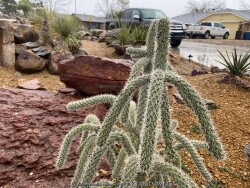

This hardy Cane Cholla came to us from Yucca Pointe Nursery in Stillwater, OK where it grows outside in the owner Nathan Priest's display garden. This upright Cholla Cactus (Cylindropuntia spinosior) features magenta flowers and upright growth form are a unique addition to the garden. Native to arid clay soils in Western Arizona and New Mexico and parts of the southwestern United States and Mexico, the plant grows into a vicious unforgiving shrub if you get too close. From a distance however, this cactus has a place as one of the few upright cacti that can handle extreme cold when kept dry. With very well drained soils and proper siting, this cactus seems to take our excess rainfall in Eastern Kansas. We are testing this outside in our crevice garden among other hardy cacti and succulents! We will keep you posted. (2024)
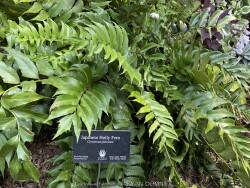

Japanese Holly Fern (Cyrtomium falcatum) is planted for its evergreen dark green foliage resemble holly branches. It is native to shaded mountain areas in forests, crevices in coastal cliffs, stream banks, rocky slopes, and other moist, stable areas in eastern Asia, India, southern Africa and even Hawaii. It is easily and quickly propagated by floating spores. It thrives in light shade to deep shade with average soil but does not tolerate poor drainage. If low temperatures hit -5 degrees F, the evergreen foliage finally dies back to the ground and re-emerges in early spring. If low temperatures hit -10 degrees F, it may kill an un-mulched plant; protect any zone 6 perennial with thick layer of mulch. Generally this plant can decline after a few years of Kansas climate but is worth a try in perfect soils in well-tended and protected shade gardens. Repeated or successive cold winters with complete foliage loss seem to be an issue with this and many evergreen zone 6/7 plants. One occasional difficult winter followed by mild winters is more tolerable. This is, however, one of the most deep shade tolerant plants available so may be worth a try. In a family member's zone 7a Stillwater OK garden, several specimens thrived for a over a decade until all were wiped out by a freak -19 degrees F cold event one winter. Amazingly, surviving spores survived to re-colonize parts of the garden.